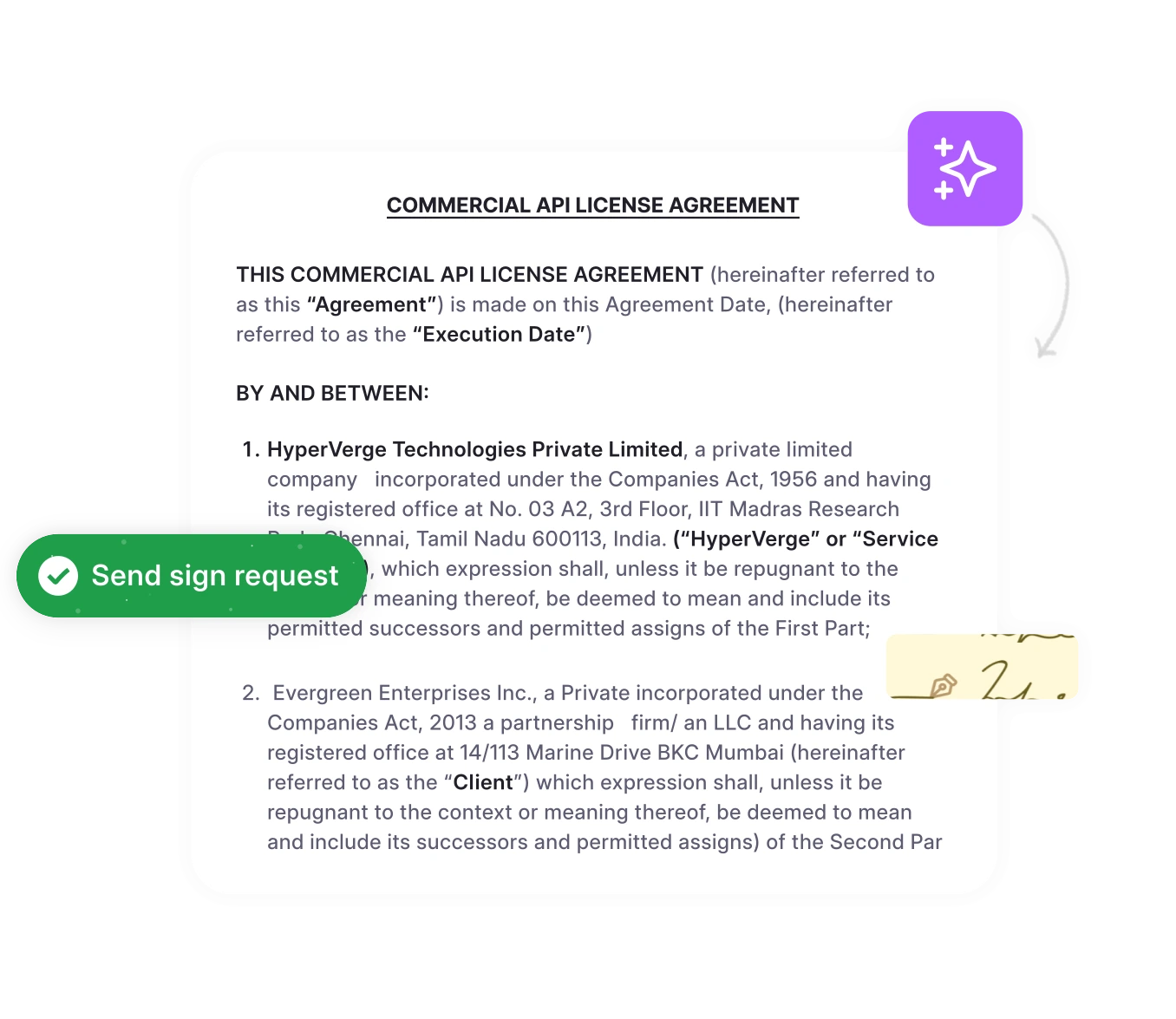If you’re planning to partner with another brand for a joint campaign, webinar, or product launch, you need a co-marketing agreement before you begin. It’s not just paperwork—it’s what keeps your partnership organized and fair.
A co-marketing agreement clearly defines who handles what, how costs are shared, who owns the leads, and how results are measured. Without one, even good collaborative contract management practices can turn into confusion over responsibilities or credit.
Co-marketing agreements are a specialized type of marketing agreement designed specifically for collaborative partnerships between multiple businesses, with unique considerations around cost-sharing, lead distribution, and co-branding.
Most marketers and business owners search for “co-marketing agreement” when they’re ready to formalize a partnership but want to avoid legal or operational mistakes. This guide will help you understand what goes into a co-marketing agreement, why it’s essential, and how to create one that protects both sides while ensuring smooth execution.
Before you start drafting your own partnership contract, here’s a ready-to-use co-marketing agreement template you can download and customize. It covers all key elements—roles, responsibilities, cost sharing, and lead ownership—to help you set clear terms from day one.
Read
Use this joint marketing agreement template as a foundation to create transparent, professional agreements that protect both partners and keep every campaign organized.
What is a co-marketing agreement?
A co-marketing agreement is a formal contract between two or more businesses that agree to promote each other’s products, services, or campaigns together. The goal is to reach a wider audience, share marketing costs, and generate leads that benefit all parties involved.
In simple terms, it’s a written plan that defines how two brands will collaborate on marketing efforts—from content creation and social media promotion to events, ads, or joint offers. It also sets clear rules on who owns the leads, how branding will appear, and how success will be measured.
Why It Matters
Co-marketing allows brands to combine strengths—like one partner’s audience reach and another’s industry expertise—to create more impactful campaigns. Having a signed agreement ensures that each party’s contributions, rights, and outcomes are transparent and legally protected.
Example
Imagine a CRM software company and an email marketing platform running a joint webinar on improving customer retention.
- The CRM team handles registration and outreach.
- The email platform manages content and post-event follow-up.
- Both share the leads collected through the campaign.
Their co-marketing agreement defines these roles, how costs are split, and how the results are shared—keeping everything organized and dispute-free.
Streamline agreements with HyperStart
Centralize all agreements, track obligations, and stay ahead of milestones on time.
Book a Demo8 Key elements of a co-marketing agreement
A well-crafted co-marketing agreement should cover all aspects of the partnership to avoid confusion and ensure smooth execution. Here are the key elements you should include:
1. Parties and their roles
Clearly define who is involved and each partner’s responsibilities. This ensures tasks like content creation, campaign management, and lead follow-up are assigned and tracked.
2. Campaign goals and objectives
Specify what the partnership aims to achieve—brand awareness, lead generation, or product promotion. Clear goals help measure success.
3. Scope of marketing activities
Detail the channels, tactics, and types of campaigns both parties will execute, including social media posts, webinars, email campaigns, and joint events.
4. Budget, cost, and resource sharing
Outline how marketing costs, ad spend, and resource contributions will be shared. This prevents contract disputes over expenses.
5. Lead ownership and data use
Define who owns the generated leads, how data will be collected, stored, and shared, and which privacy regulations must be followed.
6. Branding, IP, and content rights
Set rules for logo usage, trademarks, co-branded content, and intellectual property created during the partnership.
7. Timeline, duration, and termination terms
Include the start and end dates, contract renewal conditions, and procedures for ending the agreement if needed.
8. Confidentiality and legal clauses
Protect sensitive information and include any legal provisions, such as dispute-resolution, liability, and contract compliance requirements.
“Consulting an experienced attorney for your co-marketing agreement is strongly recommended. Legal counsel ensures that all roles, deliverables, intellectual property rights, data privacy rules, and dispute-resolution processes are adequately documented, protecting both parties and minimizing risk. Proper documentation and precise terms are critical for campaign success and legal compliance.”
Read
5 Benefits of a well-structured co-marketing agreement
A clear and detailed co-marketing agreement ensures both partners are aligned and reduces the risk of misunderstandings. Here are the key benefits:
1. Stronger brand reach and awareness
A co-marketing agreement allows both brands to combine their audiences and marketing channels. This increases visibility and helps reach new customer segments that might be difficult to access individually. By clearly defining campaign responsibilities, each partner can leverage the other’s strengths to maximize exposure.
2. Cost efficiency and shared resources
Collaborating on marketing campaigns allows businesses to share budgets, tools, and human resources. A formal agreement ensures that each partner knows their contribution, preventing overspending or duplicated efforts. This shared approach reduces costs while improving the overall return on investment.
3. Increased credibility through association
Partnering with a reputable brand enhances trust and credibility for both parties. Customers are more likely to engage with campaigns endorsed by multiple known brands. A written agreement ensures the partnership is represented consistently and professionally across all channels.
4. Better campaign performance tracking
When roles, responsibilities, and KPIs are clearly defined, it becomes easier to monitor and evaluate campaign performance. The agreement outlines how leads, engagement metrics, and results are tracked and shared. This transparency allows both partners to make data-driven decisions and improve future campaigns.
5. Legal and operational clarity
A co-marketing agreement formalizes expectations, contract obligation management, and rights, reducing the risk of disputes. It also clarifies procedures for cost sharing, branding, and lead ownership. This structured approach ensures smooth execution and provides legal protection for both partners.
“A co-marketing agreement in the United States must protect both parties’ rights by explicitly defining intellectual property ownership, compliance with federal and state data privacy laws, and dispute resolution mechanisms.
Legal review is essential to safeguard interests, prevent liability, and ensure the agreement is enforceable in relevant jurisdictions.”
Read
5 Common challenges in co-marketing partnerships
Even the best partnerships can face difficulties if expectations and processes are not clearly defined. Here are the most common challenges businesses encounter:
1. Unclear ownership of leads or results
Without a formal agreement, partners often struggle to determine who owns the leads generated through joint campaigns. This can create disputes and delays in follow-up. Clearly defining lead ownership and tracking responsibilities prevents conflicts and ensures both parties benefit fairly.
2. Misaligned target audiences
If the partnering brands target different customer segments, marketing efforts may not resonate effectively. Campaigns can fail to generate quality leads or meaningful engagement. A co-marketing agreement helps align audience strategies to maximize impact.
3. Inconsistent brand messaging
When partners do not coordinate their messaging, the campaign may confuse customers or dilute brand identity. A structured agreement sets guidelines for tone, visual branding, and content approval to maintain consistency.
4. Poor reporting or accountability
Without precise reporting mechanisms, it is difficult to measure the success of joint campaigns. Tasks may be delayed, and performance metrics unclear. Agreements outline responsibilities for tracking results and holding each partner accountable.
5. Informal agreements without legal backup
Many partnerships start with informal understandings, which can lead to misunderstandings or disputes. A formal co-marketing agreement legally documents each party’s obligations and ensures compliance with contractual and regulatory requirements.
5 Best practices for successful co-marketing agreements
Following best practices ensures your co-marketing partnership runs smoothly and delivers measurable results. Here are the key strategies to consider:
1. Choose partners with aligned goals and values
Selecting a partner whose business objectives, target audience, and brand values align with yours is critical. Misalignment can reduce campaign effectiveness and create friction. A shared vision ensures both brands work toward common outcomes.
2. Define success metrics (KPIs) from day one
Agree on measurable outcomes such as leads generated, website traffic, or engagement rates before starting the campaign. Clear contract management KPIs help track progress and objectively evaluate performance. This avoids confusion about expectations or results later.
3. Maintain regular communication
Frequent updates and check-ins keep both parties informed about campaign progress. Open communication allows teams to address issues quickly and make adjustments as needed. Agreements should outline communication channels and frequency.
4. Use agreement templates or legal review
Standardized templates and legal review help ensure that all essential elements are covered, including costs and roles, as well as intellectual property and lead ownership. A formal review prevents omissions and reduces potential legal risks.
5. Keep all deliverables and timelines documented
Documenting tasks, deadlines, and responsibilities keeps campaigns organized and accountable. This ensures that both parties fulfill their commitments and allows for easy tracking of campaign milestones and outcomes.
Manage agreements efficiently
With HyperStart, you can monitor obligations and stay on top of collaborations without missing a detail.
Book a Demo6 Step-by-step process to create a co-marketing agreement
A structured approach ensures that your co-marketing partnership is transparent, fair, and effective. Here’s a step-by-step process to follow:
1. Identify potential partners
Start by researching and selecting businesses that complement your products, services, or audience. Consider reputation, market reach, and values to ensure a productive partnership.
2. Define campaign scope and shared goals
Agree on the campaign’s objectives, target audience, channels, and deliverables. Documenting this early ensures both parties are aligned and sets a benchmark for measuring success.
3. Draft the agreement (roles, costs, KPIs)
Create a formal agreement that outlines each partner’s responsibilities, resource contributions, cost-sharing, and key performance indicators. This reduces contract ambiguity and establishes accountability.
4. Review and negotiate terms
Allow both parties to review the draft and suggest changes. Contract negotiation ensures mutual satisfaction, addresses potential conflicts, and finalizes responsibilities and legal obligations.
5. Sign, execute, and monitor activities
Once signed, launch the joint campaign and monitor progress against agreed KPIs. Regular tracking helps identify issues early and ensures that both partners fulfill their commitments.
6. Evaluate results and renew or close the partnership
After the campaign ends, assess outcomes against objectives. Discuss lessons learned, decide whether to renew, modify, or end the agreement, and document insights for future collaborations.
Examples of co-marketing in action
Real-world examples help illustrate how co-marketing agreements work and the benefits they bring to both partners. Here are a few practical scenarios:
1. SaaS + CRM integration campaigns
A software-as-a-service (SaaS) company partners with a CRM provider to create a joint webinar on improving customer retention. The SaaS company handles registration and content, while the CRM provider promotes the event to its audience. Both share leads and measure campaign performance in accordance with the agreement.
2. Fitness app + nutrition brand partnerships
A fitness app teams up with a nutrition supplement company to run a co-branded challenge. The fitness app provides workout plans, while the nutrition brand supplies recipes and discount codes. The co-marketing agreement outlines responsibilities, promotional channels, and lead sharing rules.
3. Retail brand + local influencer promotions
A retail clothing brand collaborates with local influencers to launch a seasonal campaign. Influencers create content and share it with their followers, while the brand provides products and tracks engagement. The agreement defines content rights, timelines, and compensation.
4. Tech company + educational platform campaigns
A tech company joins an online educational platform to create a series of tutorial videos. The tech company provides software access, while the platform handles student promotion. The agreement specifies branding guidelines, performance metrics, and, if applicable, revenue sharing.
Using HyperStart, businesses can centralize contract tracking and manage all co-marketing agreements, ensuring accountability and smooth execution across campaigns.
How HyperStart simplifies co-marketing agreements
Managing multiple co-marketing partnerships can be challenging. From tracking responsibilities and deadlines to securely storing agreements, manual processes are prone to errors and delays. HyperStart, contact management software, provides a centralized, automated solution that ensures all your co-marketing contracts are organized, transparent, and actionable.
Here’s how HyperStart can help your business manage co-marketing partnerships effectively:
- Centralized contract repository: Store all co-marketing agreements in one secure location, accessible to authorized teams anytime. This prevents lost documents and version confusion.
- Automated workflow and approvals: Draft, contract review, and approve agreements efficiently with automated workflows. AI-powered redlining and notifications ensure contracts are finalized quickly and accurately.
- Obligation tracking and reminders: Monitor key milestones, deadlines, and deliverables. Automatic reminders help ensure campaigns, payments, and joint activities are completed on time.
- Cross-team collaboration: Marketing, legal, and sales teams can collaborate within HyperStart with role-based access and permissions. Everyone stays aligned while maintaining control over sensitive information.
- Performance insights and analytics: Track campaign performance, leads, and ROI as per the agreement terms. Data-driven insights help optimize current and future partnerships.
By combining a clear co-marketing agreement with HyperStart’s contract management features, businesses can reduce risks, improve accountability, and maximize the success of every partnership.












